
11 minute read
FRANCISCO MANUEL AVILA
Introduction
Francisco Manuel Ávila Moreno / ARTICLE • Teacher at the Escuela de Entrenadores, professor at the Universidad Pablo de Olavide, coach of the
Advertisement
Viso del Alcor youth team, former coach of the
ASOBAL and DH Plata and former Spanish youth naNonal team. • Youth team coach el Viso del Alcor, former
ASOBAL and DH Plata coach and former Spanish youth naNonal team coach).
On several occasions I have been asked to give my perspective on defending 6x7, a task that I do not avoid, but which I postpone in order to address the defence in inferiority in a global way, we must not reverse the order of the processes, laying the foundations, the fundamentals, is the first step to be able to address more specific situations later on. I invite the reader to review the recommended references at the end of the article. My reflection is that, although the differences in attack: the quality of the attackers (the potential for shooting, the anthropometry of the pivots, ...), structure (open pivots, in the centre or charging a lateral zone), or intentionality of the game (enabling shots, inside passes or outside superiority), nuance the defence, together with my own defensive strengths or weaknesses, we find common bases to any defence in inferiority. I will try to describe them, following the spirit of this magazine, starting from proposals of practical activities by selecting some key objectives organised on three structural levels: collective (team), group (coordinations or basic means) and individual (which does not mean isolated).
Defending in inferiority requires: A collective organisation that facilitates sufficient density in the ball zone. A coordination of means that allows different levels of individual anticipation and compensates for disadvantages. A formation of the defender that enables him to defend his space from the opponent and the ball simultaneously, provide assistance outside his zone, and intervene in the attacking circulation (it is in this formation where we will place more emphasis).
Defensive organisation (tilting, differentiating functions).
Defensive tilting, even when the team is in a low position, must always seek to increase the defensive density in the ball zone. In order to do this, it is not enough to follow the ball, the zone away from the ball (there are degrees) must intervene on the ball by creating doubts, slowing it down, moving it away from the near zones, or even orienting it. In this idea, defensive roles must be clearly differentiated according to the proximity of the ball.

EVITAR PROGRESIÓN AYUDAS
CERRAR ESPACIOS DISUADIR PASES ACTUAR SOBRE EL PASE (DISUADIR – INTERCEPTAR) ALEJAR EL ATAQUE AMORTIGUAR INFERIORIDAD
PracNcal proposals:


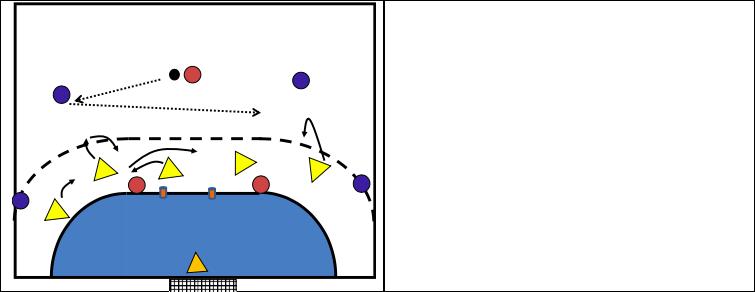

Basic means or group coordina-on (odd-even pressure; sliding; assists).
When it comes to defending situaNons of inferiority, we start from an iniNal idea, "the imbalance is already expected to occur", so we must progress in the ability to adjust collecNvely to the zone and to the intervenNon of my teammates. Combining tacNcal weapons, varying their use, from help, anNcipaNon and sliding, should allow us to "collecNvely have opNons for success" . A key idea is that "transforming simple inferiority situaNons into more complex situaNons, i.e. with more players involved, makes acacking resoluNon more difficult and increases defensive opNons" . In the proposed exercises, we provoke deep starNng situaNons (supposedly pressing outlets) and imbalances.
PracNcal proposals:


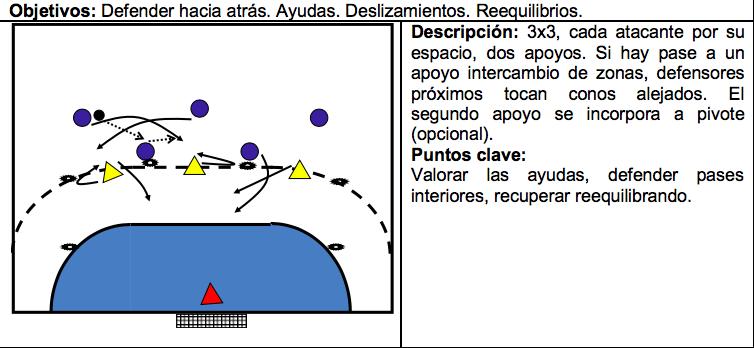

The training of the defender (simultaneous intenNons; intervening outside his zone; acNng on circulaNon).
We understand the improvement stage as "the process in which elements already acquired are modelled towards maximum efficiency", we usually idenNfy its beginning with the youth stage and its end, in my opinion, is extended unNl the player's performance is stabilised afer years of compeNNve experience. At this stage, the technical-tacNcal improvement is given by the increase of the modes, the correcNon of key points for efficiency, and the improvement in decision making in different compeNNve situaNons. In order to defend at a disadvantage, the player should be able to: come out without forgeÑng to defend the pass, decide at speed, intervene successively in adjacent areas, alternate intervenNons on the opponent and the ball.

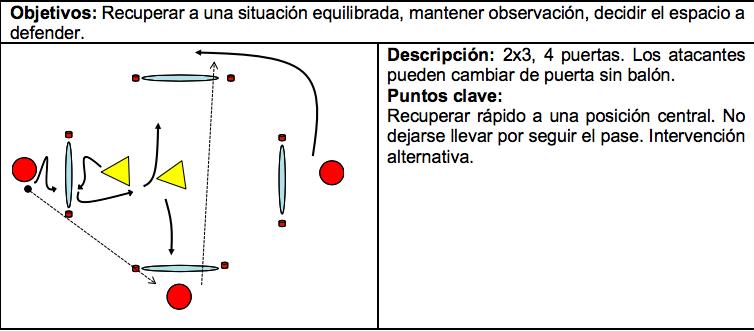


Referencias bibliográficas recomendadas: • Ávila, F. M. (2006). La formación defensiva del jugador en su incorporación al alto rendimiento. Área de balonmano, 38 • Ávila, F.M. (2015). La velocidad desde y para la defensa. Formar defensores veloces. Área de balonmano, 64, • Ávila, F.M. (2015). Defender al pivote atacante: trabajo global del equipo. Ebalonmano.com: Revista de Ciencias del Deporte 11(2), 143-166. • Ávila, F.M. (2020). Construir nuestro sistema defensivo zonal. Área de Balonmano, 76, 1014. AEBM. • Gerona, Toni (2019). La defensa en inferioridad ante 7 atacantes. El juego 6x7. Área de
Balonmano, 75, 10-13. AEBM. • Laguna, M. (2017). Una necesidad, defender 6x7. Clinic Copa de CasJlla y León.


Sideline Sports Super Amara Bera Bera assistant coach Responsible Sideline Sports in Spain and South America
Alex Nogués
Presentaciones
Llegado el momento de presentar nuestra información a jugadores/as o técnicos en XPS tenemos varias opciones.
La principal y más completa es el módulo de Presentaciones. Desde aquí una vez cargados los clips de video que nos interese, se nos presenta una línea de tiempo. Donde podemos ordenarlos, modificar su longitud de tiempo, su velocidad de reproducción, duplicarlos, etc..
Para focalizar la atención podemos utilizar la inserción de títulos, fondos de color y dibujo sobre el video.
Esta última opción de dibujo sobre video, es una de las principales características de las Presentaciones.
Dibujar en video
Varias son las opciones de dibujo: focos, lineas, texto. Con la capacidad de dar a cada elemento el tiempo y duración que nos interesa para presentar la información más relevante del video.
Exportar video
La exportación de video en XPS está totalmente automatizada, utilizando una herramienta eficiente en cuanto a calidad del video final cómo la velocidad de exportación. Algo que nuestros clientes valoran como uno de los puntos fuertes del programa. SVA - PRESENTACIONES
Realizados los análisis y estudiadas las estadísticas, queda dar el paso de mostrar la información. Para ello en XPS tenemos la herramientas de Presentaciones/Presenter
Desde esta herramienta, que sería el equivalente a un editor de video, podemos añadir fondos de color, texto, fotos y por supuesto videos; videos que añadimos directamente desde listas de eventos, consultas o desde los propios análisis de video.
Una de las herramientas más completas en este módulo de Presentaciones es la opción de Dibujo. Con ella podemos dibujar sobre la imagen de video para dar más información o centrar la atención en alguna parte del video
La parte final de las Presentaciones es la exportación del trabajo, podemos compartirlo directamente con nuestro grupo de trabajo o exportar a un video fuera del programa.







JUAN PEDRO LAMA ZURITA
FEMALE INFANTILE TEAM COACH HANDBALL TRIANA (SEVILLA) COACHING STAFF TEAM 1ST NATIONAL MEN'S HANDBALL TRIANA (SEVILLA)
• C.D. Balonmano Triana was born in the 1978/1979 season. More than 40 years of existence. It has its origins in
Elena Canel's Club Vivero. It was one of the first neighbourhood clubs in
Seville, whose work was carried out entirely in Triana, and more specifically in the Barrio del Tardón, in the Elena Canel school (now CEIP.
Alfares) and in the Instituto G. Adolfo
Bécquer. Adolfo Bécquer Institute.
But this illusion, little by little, grew, both in participants, as well as in technification, increasing the number of teams and coaches at the same time as their sporting successes, which is why it had to open up to the rest of
Seville. • It is, therefore, the objective of C.D.
Balonmano Triana, to return the splendour that handball has had in other times in our city, although from this modest Club, it has always been in sporting disposition to reach national levels typical of a city like
Seville. A milestone achieved with the promotion to the 1st National
Men's Handball Division in the 2017/2018 season, joining the
Women's Team, also in the 1st
National Women's Division. After a season in the 2nd National Division (for non-sporting reasons), again this season we achieved promotion to the 1st National Division.
6 ESCUELAS DEPORTIVAS MUNICIPALES CON 140 NIÑOS


The present tasks that I am going to present in the article, I am going to differentiate them in the different phases of the withdrawal, as I show in the following scheme:



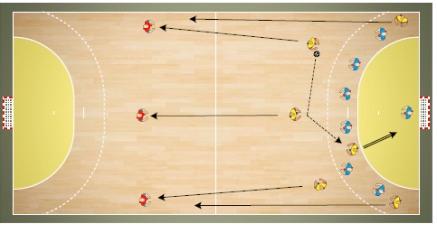

EXERCISE NO. 1 CHANGE OF ROLE IN RETREAT
ATTACK + DEFENSIVE BALANCE 6x6
DESCRIPTION
We start with a 6x6 attack, when there is a goal we work fast counter-attack and there must be 4 players in our own half of the field before the opposing team's kick. If there is a defensive recovery or a save by the goalkeeper, you have to retreat quickly to avoid the pass to one of the three receivers who are 5 metres in their own half.
Objective:
Attack-defence role change, work on attitude in balance, anticipation.
Variants:
Variant 1: There must be 5 players in their own half, or bring them 1 metre closer in their own half, increasing the difficulty.


INFORMATION TO USE
• If the acack is with quality and I select the shot well, I have an advantage in the defensive balance.
• When you perceive a loss, you have to change roles, not just look at the result.
• AÑtude is fundamental, a culture of effort.
• I value staying for the rebound
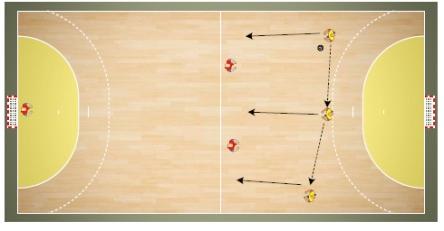

EXERCISE NO. 2 TRANSITION IN THE ASSEMBLE
2x3 DEFENSIVE BALANCE
Start with a 2x3 defence all over the field, for the attackers, each keeping their own attacking lane.
Objective: To take the attackers to the least effective zone, intercepting the ball.
Variants:
Variant 1: Favouring the defence by reducing the width of the field or eliminating the bounce.
INFORMATION TO BE USED
• Do not retreat backwards, it is very slow, run forward and turn your head. • Deter, dissuade, so that the player with the ball spends pots away from the goal and defend possible passes to the other acackers. • Try to slow down the counter-acack to take them to less effecNve areas. • CommunicaNon between defenders is important • Adequate defensive orientaNon • Assess who shoots, avoiding the specialist, it is preferable that he shoots first line or defensive specialist.

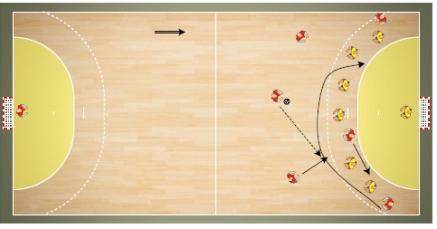
EXERCISE NO. 3 DEFENSIVE ORGANISATION IN THE RETREAT
ATTACK + DEFENSIVE BALANCE 6x6
It starts with a 6x6 attack where, working on the attacking procedure, a winger has to circulate and there has to be a throw-in. The thrower always has to touch the goal post, to work the retreat in inferiority. If there is a goal, counter-attack with a quick kick.
Objective: To work on order in the retreat, to close the ball zone, to work on different specific positions and to maintain the defensive structure.
Variants:
Variant 1: Working with acack-defence changeover
Variant 2: Working with acack-defence switching without goalkeeping


INFORMATION TO BE USED
• There are no specific posiNons in the retreat, the defensive structure must be maintained.
• Protect the side of the thrower who has fallen behind in the retreat.
• The one who lags behind has more vision to decide where to posiNon himself.
• Try to slow down the counter-acack in order to lead them to less effecNve areas.








